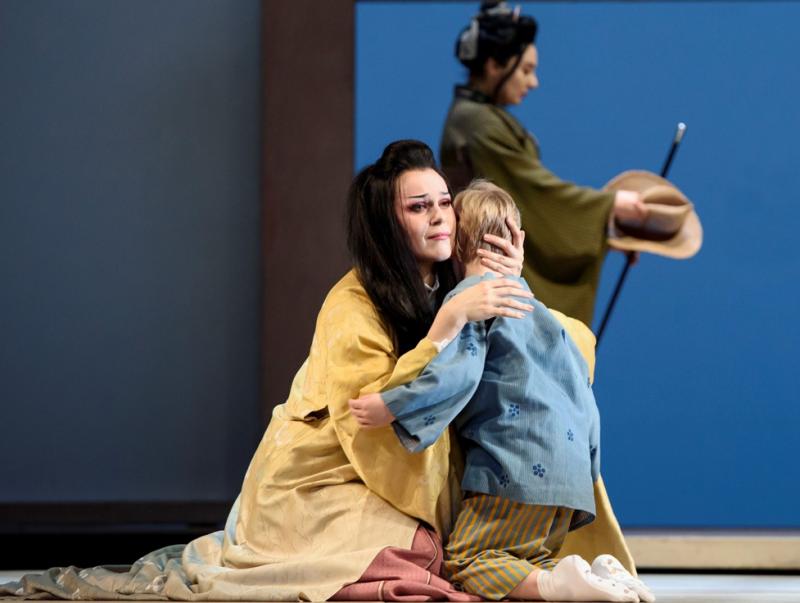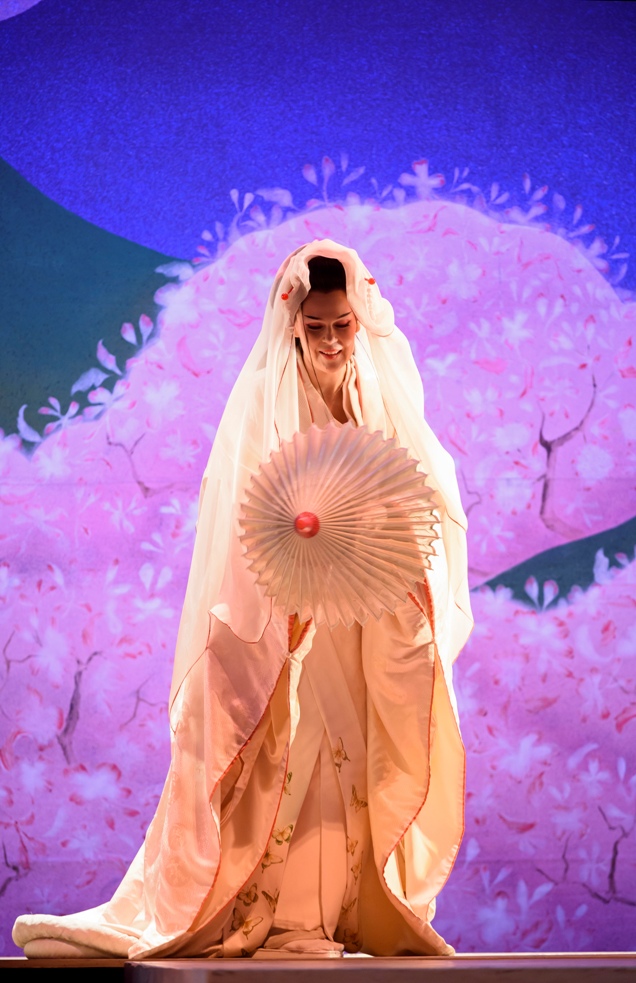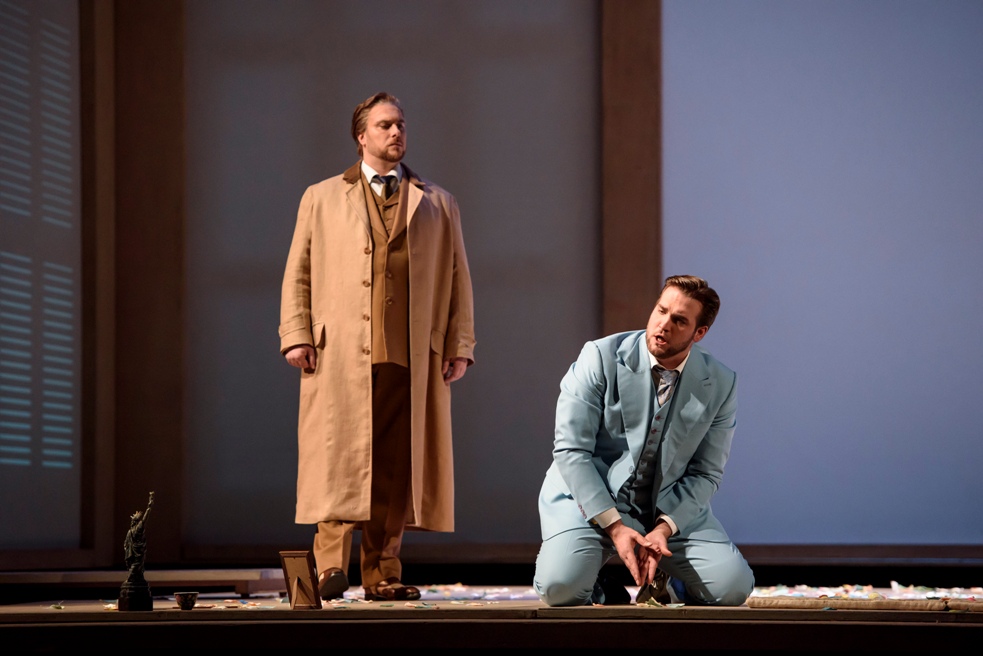Madama Butterfly, Royal Opera | reviews, news & interviews
Madama Butterfly, Royal Opera
Madama Butterfly, Royal Opera
Great conductor and soprano realise Puccini's deepest heartbreak to perfection

When is a famous aria more than just a showpiece? When it’s a narrative of a future event conjured by a hope beyond reason, which is what Madama Butterfly’s “Un bel dì” (“One fine day”) ought to be but so rarely is: too often prima donna overkill and stereotyped mannerisms get in the way. Not with Latvian soprano Kristine Opolais.
Opolais (pictured below in Act One) makes every word tell especially in the crystal-clear middle range. The tone can curdle in the higher reaches, but only when she doesn’t use her exciting lirico spinto resources, which are vibrant if not incandescent. But her Italianate style has all the artistry of Mirella Freni and Renata Scotto, and this Butterfly is a complete and multi-hued creation.
 The urgency and detail are perfectly mirrored in Nicola Luisotti’s conducting, as perfect in pace and colour as a Puccini performance possibly can be. That’s saying something when the house Puccinian, Antonio Pappano, has until now seemed to have no peer, and when Opolais’s husband, Andris Nelsons, one of the conducting world’s greatest hopes at the moment, shared her triumph back in 2011. But I really can’t remember this masterpiece among opera scores – as perfect, in its own compressed way, as anything by Wagner – ever having its many diamond facets so finely buffed.
The urgency and detail are perfectly mirrored in Nicola Luisotti’s conducting, as perfect in pace and colour as a Puccini performance possibly can be. That’s saying something when the house Puccinian, Antonio Pappano, has until now seemed to have no peer, and when Opolais’s husband, Andris Nelsons, one of the conducting world’s greatest hopes at the moment, shared her triumph back in 2011. But I really can’t remember this masterpiece among opera scores – as perfect, in its own compressed way, as anything by Wagner – ever having its many diamond facets so finely buffed.
Even a single shadowy note held by two double basses can chill the blood as all illusions are stripped away and Butterfly finally realises that not only will the “Yankee vagabondo”, B F (as in bloody fool) Pinkerton, who married her on a short lease and a libido-driven whim, won’t be returning but also that his new wife wants to take Butterfly’s blond-haired, blue-eyed child back to America with them. At this frozen point in the action, all audience coughing is stilled and you can hear a pin drop.
On a superficial level, it’s also worth noting about this extraordinary scene what a wonderful thing the operatic world is when three fine singers who happen to be Latvian, Albanian and Armenian share a stage singing Italian: they are, respectively, Opolais, Enkelejda Shkosa, whose big-hearted maid Suzuki shows that she’s big of voice, too, when she emerges horror-struck from the shadow of her mistress, and Anush Hovhannisyan, who can’t possibly make much of a vocal mark as Kate Pinkerton but, as those of us who saw her in Chelsea Opera’s Le Roi de Lahore know, is a diva who won't have to wait long for her moment in the sun.
The males of the “American” species are stalwart but relatively uninvolving. Brian Jagde’s heavyweight tenor is well contrasted at the start with the lighter sound of Carlo Bosi, luxury casting in the cameo role of the odious marriage-broker Goro, and he hits all the high notes with full-blooded energy. But there needs to be more in the way of sunshine and roses in the voice if we’re to find him an attractive bounder (the hard-hitting supertitles spare us nothing of Pinkerton’s insensitivity from the start). Gabriele Viviani’s baritone could be smoother, and not enough of Consul Sharpless’s sympathy comes across in another slightly stiff performance, but again it’s perfectly serviceable. Their trio with Suzuki is a glowing highlight.
 At least both men look good in uniform and stylish suits (pictured left), Agostino Cavalca’s costumes perfectly in tune with Christian Fenouillat's clean and handsome set, a bare wooden space to emphasise the performers, with screens and shutters lifting to reveal diverse backdrops: a sepia-tinted Nagasaki, garden flowers for Butterfly and Suzuki to gather, and, best of all, a blooming Japanese idyll which collapses to reveal Butterfly’s vengeful uncle the Bonze (Jeremy White), alarming against black. Moshe Leiser and Patrice Caurier have every reason to remain proud of their work in the hands of skilful revival director Justin Way: from high in the Royal Opera House, the groupings for the wedding look ravishing and Christophe Forey’s lighting highlights the mood (I’m especially fond of the yellow strips against purple for the Act One love duet).
At least both men look good in uniform and stylish suits (pictured left), Agostino Cavalca’s costumes perfectly in tune with Christian Fenouillat's clean and handsome set, a bare wooden space to emphasise the performers, with screens and shutters lifting to reveal diverse backdrops: a sepia-tinted Nagasaki, garden flowers for Butterfly and Suzuki to gather, and, best of all, a blooming Japanese idyll which collapses to reveal Butterfly’s vengeful uncle the Bonze (Jeremy White), alarming against black. Moshe Leiser and Patrice Caurier have every reason to remain proud of their work in the hands of skilful revival director Justin Way: from high in the Royal Opera House, the groupings for the wedding look ravishing and Christophe Forey’s lighting highlights the mood (I’m especially fond of the yellow strips against purple for the Act One love duet).
The only idea which doesn’t quite come off is Cio-Cio San’s lepidopteral fluttering after her hara-kiri, an unfortunate end to an otherwise shattering denouement. But production, singing and orchestral beauty come together exquisitely in scenes such as Butterfly’s vigil with her little son (Oliver Zetterström on the first night, clearly delighted to be in the show as he bounced up and down in the curtain call). Anthony Minghella’s far more compromised ENO Butterfly committed the outrage of an interval at the end of the Humming Chorus, but here the tableau of the waiting women holds and the intermezzo which follows shows Luisotti’s conducting mastery at its most supple. We’re spellbound to the end, lost in another world that turns out to be harsh and pitiless, and you come out (at least I did) disoriented and stricken. You can’t ask more from Puccini’s far from sentimental ending than that.
The future of Arts Journalism
You can stop theartsdesk.com closing!
We urgently need financing to survive. Our fundraising drive has thus far raised £49,000 but we need to reach £100,000 or we will be forced to close. Please contribute here: https://gofund.me/c3f6033d
And if you can forward this information to anyone who might assist, we’d be grateful.

Subscribe to theartsdesk.com
Thank you for continuing to read our work on theartsdesk.com. For unlimited access to every article in its entirety, including our archive of more than 15,000 pieces, we're asking for £5 per month or £40 per year. We feel it's a very good deal, and hope you do too.
To take a subscription now simply click here.
And if you're looking for that extra gift for a friend or family member, why not treat them to a theartsdesk.com gift subscription?
more Opera
 Tosca, Welsh National Opera review - a great company reduced to brilliance
The old warhorse made special by the basics
Tosca, Welsh National Opera review - a great company reduced to brilliance
The old warhorse made special by the basics
 BBC Proms: The Marriage of Figaro, Glyndebourne Festival review - merriment and menace
Strong Proms transfer for a robust and affecting show
BBC Proms: The Marriage of Figaro, Glyndebourne Festival review - merriment and menace
Strong Proms transfer for a robust and affecting show
 BBC Proms: Suor Angelica, LSO, Pappano review - earthly passion, heavenly grief
A Sister to remember blesses Puccini's convent tragedy
BBC Proms: Suor Angelica, LSO, Pappano review - earthly passion, heavenly grief
A Sister to remember blesses Puccini's convent tragedy
 Orpheus and Eurydice, Opera Queensland/SCO, Edinburgh International Festival 2025 review - dazzling, but distracting
Eye-popping acrobatics don’t always assist in Gluck’s quest for operatic truth
Orpheus and Eurydice, Opera Queensland/SCO, Edinburgh International Festival 2025 review - dazzling, but distracting
Eye-popping acrobatics don’t always assist in Gluck’s quest for operatic truth
 MARS, Irish National Opera review - silly space oddity with fun stretches
Cast, orchestra and production give Jennifer Walshe’s bold collage their all
MARS, Irish National Opera review - silly space oddity with fun stretches
Cast, orchestra and production give Jennifer Walshe’s bold collage their all
 Káťa Kabanová, Glyndebourne review - emotional concentration in a salle modulable
Janáček superbly done through or in spite of the symbolism
Káťa Kabanová, Glyndebourne review - emotional concentration in a salle modulable
Janáček superbly done through or in spite of the symbolism
 Buxton International Festival 2025 review - a lavish offering of smaller-scale work
Allison Cook stands out in a fascinating integrated double bill of Bernstein and Poulenc
Buxton International Festival 2025 review - a lavish offering of smaller-scale work
Allison Cook stands out in a fascinating integrated double bill of Bernstein and Poulenc
 Tosca, Clonter Opera review - beauty and integrity in miniature
Happy surprises and a convincing interpretation of Puccini for today
Tosca, Clonter Opera review - beauty and integrity in miniature
Happy surprises and a convincing interpretation of Puccini for today
 Hamlet, Buxton International Festival review - how to re-imagine re-imagined Shakespeare
Music comes first in very 19th century, very Romantic, very French operatic creation
Hamlet, Buxton International Festival review - how to re-imagine re-imagined Shakespeare
Music comes first in very 19th century, very Romantic, very French operatic creation
 Falstaff, Glyndebourne review - knockabout and nostalgia in postwar Windsor
A fat knight to remember, and snappy stagecraft, overcome some tedious waits
Falstaff, Glyndebourne review - knockabout and nostalgia in postwar Windsor
A fat knight to remember, and snappy stagecraft, overcome some tedious waits
 Salome, LSO, Pappano, Barbican review - a partnership in a million
Asmik Grigorian is vocal perfection in league with a great conductor and orchestra
Salome, LSO, Pappano, Barbican review - a partnership in a million
Asmik Grigorian is vocal perfection in league with a great conductor and orchestra
 Semele, Royal Opera review - unholy smoke
Style comes and goes in a justifiably dark treatment of Handelian myth
Semele, Royal Opera review - unholy smoke
Style comes and goes in a justifiably dark treatment of Handelian myth

Add comment